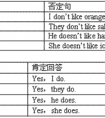用所给单词的正确形式填空。1.Let's(clean)thewindows.2. When's(he)birthday?3. Nowthechildrenare(sing)thesong.4. Benoften (have)breakfastatseveninthemornin-六年级英语
题文
| 用所给单词的正确形式填空。 |
| 1. Let's (clean) the windows. 2. When's (he) birthday? 3. Now the children are (sing) the song. 4. Ben often (have) breakfast at seven in the morning. 5. Mike (not) like listening to music. 6. Do you like (collect) stamps? 7. We are (have) a birthday party. 8. There (be) a big cake and some candles. 9. Yang Ling's uncle (live) in a town near Nanjing. 10. He usually (go) shopping at Spring Festival. |
答案
| 1. clean 2. his 3. singing 4. has 5. doesn't 6. collecting 7. having 8. is 9. lives 10. goes |
据专家权威分析,试题“用所给单词的正确形式填空。1.Let's(clean)thewindows.2. Wh..”主要考查你对 there be 句型,物主代词,一般现在时,动词单数第三人称,现在进行时,现在分词,动名词,助动词 等考点的理解。关于这些考点的“档案”如下:
there be 句型物主代词一般现在时,动词单数第三人称现在进行时,现在分词动名词助动词
考点名称:there be 句型
- There be句型:
是英语中常用句型,意思是“有”,表示“人或事物的存在”。
There在此结构中是引导词,已经没有副词“那里”的含义。
There be后面的名词是句子的主语,属倒装结构。常用“There + be+名词+地点/时间状语”的结构。 - There be结构的用法:
A、肯定结构:
There be句型的肯定结构表示“某处存在某物或某人”或“某时发生某事”。
a. There is+单数可数名词/不可数名词+地点/时间状语。
例:There is a cat under the chair. 椅子下面有一只猫。
There is some water in the bottle. 瓶子里有些水。
b. There are +复数名词+地点/时间状语。
例:There are some apples in the basket. 篮子里有一些苹果。
B、否定结构:There be句型的否定结构是在谓语动词be的后面加“not (any)”或“no”.
例:There are no tables in the room. 或者There are not any tables in the room. 房间里没有桌子。
C、疑问结构:There be句型变成疑问式时,要把there和谓语动词be的位置互换。
例:Is there a pen in the schoolbag? 书包里有一支笔吗? - Therebe结构和have的区别与联系:
1.区别点:
there be 意为存在,强调某地有某物,不表示所属关系;
have 表示所有关系, 强调某人或某地有某物,这是其基本用法。如:
There are some trees in front of the house.房前有些树。
Tom has many friends in China.汤姆在中国有许多朋友。
2.相同点:
在表示结构上的含有时,既可以用there be 句型,也可以用have(has) 来表示。如:
中国有许多长河。
There are many long rivers in China.
China has many long rivers.
三月份有多少天?
How many days are there in March?
How many days has March? - There be结构中的be动词的确定:
A、there be 结构中的谓语动词be在人称和数上应与其后的主语保持一致。主语是不可数名词或单数可数名词时用is,是复数时用are。
例:There is a flower in the bottle. 瓶里有一朵花。
There is some money in the purse. 钱包里有些钱。
B、若句子中有几个并列的主语时,be的形式要与离其最近的一个主语在人称和数上保持一致。
例:There is a boy, a girl and two women in the house. 房子里有一个男孩,一个女孩和两个妇女。
There are ten students and a teacher in the office. 办公室里有十个学生和一个教师。
There be结构的句型转换:
A、否定句:
there be的否定式通常在be后加not构成(在口语中be时常与not缩写在一起)。如果句中有some,一般要变成any。 例:
There are some children in the picture.
There aren't any children in the picture.
B、一般疑问句及其答语:
把be提到there前,首字母大写,句末用问号即可。其肯定答语是Yes, there is / are;否定答语为No, there isn't / aren't。 例:
— Are there two cats in the tree?
— Yes, there are. (No, there aren't.)
C、特殊疑问句及其回答
a. 提问句子的主语(包括主语前的修饰语)时,句型一律用“what is+地点介词短语?”(无论主语是单数还是复数都用is)。
例:There are some birds in the tree. → What's in the tree?
b. 就there be后面的地点状语进行提问时,句型用“where is/ are+主语?”
例:There is a car in the street. → Where is the car?
c. 提问可数名词(主语)前的数量时,用how many,句型结构为“how many+ 复数名词+are there+其它)”(主语无论是单数还是复数,be通常要用are)。
例:There are three books on the desk. → How many books are there on the desk?
考点名称:物主代词
- 物主代词:
表示所有关系的代词叫做物主代词,也叫人称代词的所有格。物主代词分为名词性物主代词和形容词性物主代词两种。其中,形容词性物主代词后面需加名词;
名词性物主代词可直接作名词用,后面无需再加名词。




